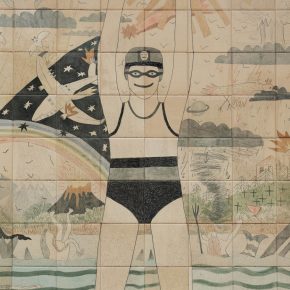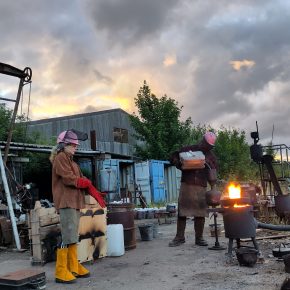Studio Conversation with Studio Holder Oana Stanciu
When did you come to ESW?
I started working at ESW in 2019 when I was on a residency from the Royal Scottish Academy. I wanted to bring sculpture and ceramics into my art practice and I spent some time at ESW exploring sculpture and making objects to use in my performances for the camera. I really loved working here and I didn’t want to leave, so I applied to get a Project Space first for a few more months and later on I managed to get selected to have a longer term Studio, which has completely changed my life in a good way. I love coming to work here, the atmosphere, people and facilities are all amazing, I feel really lucky to be part of the ESW community.
You are not a typical artist for a sculpture community, are you?
Well, what I do, I guess it’s a mix of performance, photography, moving image and sculpture. I like thinking of my body as a sculptural material that I can shape in different ways using unusual positions, objects and environments to change my appearance and turn myself into surreal creatures and characters. I perform in front of the camera so the resulting work is most of the time photography and video, so I think of myself as a visual artist rather than a photographer, or sculptor…
Who do you find yourself related with?
I’ve been told many times that my work reminds people of Francesca Woodman’s photographs which I love but, embarrassingly, I wasn’t aware of her work when I started. I think maybe Man Ray and Cindy Sherman inspired my work more – I really love the atmosphere in Man Ray’s photographs and I can relate to Cindy Sherman’s way of working, using ourselves as the subject and using playful ways of changing our identity. In 2019 I was over the moon when the Ingleby gallery invited me to show my work in a group exhibition called ‘Sometimes I disappear’ with Francesca Woodman, Cindy Sherman and the South African artist Zanele Muholi. It was amazing to have my work in the same space as such amazing artists that I admire so much.
You started working with your body. Was it from the start or is something that you discovered on your way?
It was during university when one of the teachers gave us an assignment to try and reinvent our identity. My colleagues and my friends, even my tutors, always noticed my long neck and joked about it in an endearing way, and then it clicked – I was going to turn myself into this weird character with a very long neck. I got a camera and photographed myself doing simple, everyday activities. For example, sitting on the sofa, carrying wood for fire or just being around in the house. Then I slightly elongated my neck in Photoshop but just enough to make it look like it was normal at first glance but at a second look to realise that something is not quite normal. I really enjoyed it and I had really good responses from my tutors and my colleagues so I continued working in this way, but now the challenge was not to use Photoshop and to try and distort my body in real life to make it look Photoshopped but without using the editing software.
I usually work on a theme or I gather some objects that connect to each other and start playing with them until some interesting ideas and shapes come out. So usually is a series of black and white self portraits where I embody different characters or creatures inspired by these objects or themes. Then I would choose one or two characters from a series and bring them to life through video. It’s my way of trying to make this surreal world a bit more believable, and show that my characters are very comfortable in their own skin. The videos usually focus on repetitive movements or gestures with subtle edits and distortions that help enhance the atmosphere of the series.
As well as having moving image alongside the photographs, I also work on stand alone video installations. For example, in 2017 I worked entirely with moving image, creating a stand-alone, immersive video installation over nine monitors around ideas of repetition and rituals and in 2023 I made a 14 minute video piece as part of an immersive installation inspired by extinction and rewilding, working in collaboration with a dancer, live musicians and set design. This piece is called The Anthropocenic Garden and I used a mix of performance and sculpture, blending my body with different objects to embody the creatures in the film. This was also the first time I had experimented with using a green screen, which removed the background and opened up new editing possibilities.
Would you do this in front of an audience? Have you done this in front of an audience?
Although my performances are mainly for the camera, I have actually performed live once in Norway. In 2019, I was invited to show some of my work in an exhibition and to do a performance workshop with the students from Alesund college of art. I exhibited a series of photographs called ‘The Raw’ in which I used only fruit and vegetables and worked with five students to develop a live performance for the opening night, inspired by these photographs. We went to the local shop and bought some fruit and vegetables and worked with the students to develop movement using these items. It was great, and we also had one of the students making live soundscapes to accompany the performance.
I’ve noticed that you did teach a few times, what do you think about teaching?
I enjoy teaching, I have done quite a few workshops over the years for different organisations but I also like working with students for longer periods of time, but that is a bit more rare. I like getting to know the people who I’m working with and helping them find their voice or style and see them progress. I’ve been doing this for the last few years with Leith School of Art, teaching a week on performance and lens based media and even though a week is quite short we have always managed to get some really strong images by the end of it.
You told me once that you are thinking of a project about superstitions.
Yes, it’s still in the back of my head. I would really like to do a project that brings me back home a bit more. In Romania, especially in rural areas, people are quite superstitious. And I find myself thinking things and believing things that I don’t question because I grew up surrounded by them and saying them out loud as a mature person, sometimes makes me realise that it’s complete nonsense. We’ve got quite a lot of interesting traditions and superstitions mainly around birth, marriage and death, so I would love to explore this a bit more.

Please, find more about Oana’s work here.
Mihaela Coman, artist and PhD student at Edinburgh College of Art, started this series of interviews during her Scottish Graduate School for Art & Humanities placement at ESW in 2023.




